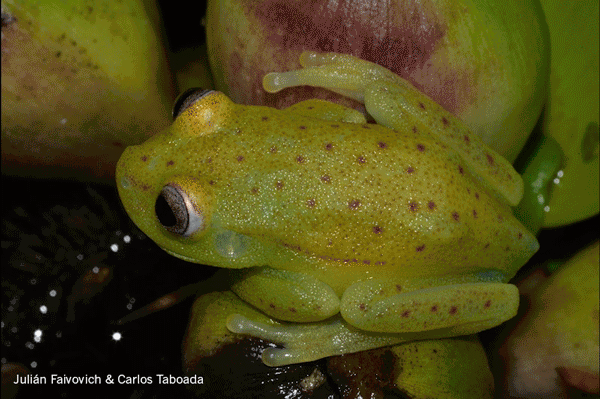Researchers Find the First Naturally Fluorescent Frog Species
The polka-dot tree frog emits a blue-green glow under UV light, which is an unusual feature for land-dwelling critters
/https://tf-cmsv2-smithsonianmag-media.s3.amazonaws.com/filer/cd/67/cd676e43-a00a-4bea-bfe4-35043f41ed50/srw3bpr0.jpg)
South America is home to all manner of crazy-looking amphibians, from vibrant poison dart frogs to cartoon-looking red-eyed tree frogs. And another one just joined the ranks: the polka-dot tree frog, Hypsiboas punctatus.
Though the species appears banal in regular light, sporting small red polka dots across its mostly green body, shine a little ultraviolet light on it and it's a completely different story. As Anna Nowogrodzki reports for Nature Hypsiboas punctatus is the first naturally fluorescent amphibian ever discovered.
Fluorescence occurs when a surface absorbs short wavelengths of light and re-emits it at longer wavelengths, explains Nowogrodzki. For instance, when UV light (short wavelength) hits a fluorescent object, it reflects back as visible light (longer wavelength), casting an eerie blue, green or red glow. While many underwater species including fish, corals, sharks and even sea turtles have fluorescent elements, the phenomenon is rare in land animals, and has only been observed in certain species of parrots and scorpions.

As Sam Wong reports for New Scientist, the discovery of the polka-dot tree frog's fluorescence was a happy accident. Julián Faivovich and his colleagues at the Natural Sciences Museum in Buenos Aires, Argentina, were studying the pigments in the tree frog when they shone a UV light on the creature. “For some things we were planning on doing, we had to illuminate the frog tissues with UV light,” Faivovich tells Wong. “Then we realized the whole frog was fluorescing.”
Looking deeper into the shiny pigments, they found that the fluorescence is comes from a set of compounds they call hyloins. The researchers published their results in the journal Proceedings of the National Academies of Sciences.
So what’s the purpose of a day-glo frog? The purpose is largely unknown for most cases and may not be important for survival. "Many animals may light up simply because they happen to have common, naturally fluorescent molecules in their bodies, not because there's a particular benefit they get from glowing," writes David Moscato at EarthTouch.

But the researchers found that the blue-green light the polka-dot frogs give off is in the sweet spot of the frog's vision. According to Wong, the fluorescence makes the frogs 30 percent brighter during twilight and 19 percent brighter during the full moon. Though it might just be a coincidence, it’s possible that the fluorescence makes the frogs visible to each other at night, when they are most active.
“We think a lot about multimodal signals, both noises and visual,” herpetologist David Blackburn at the University of Florida in Gainesville tells Wong. “Thinking about fluorescence playing a role in that could be really exciting.”
The polka-dot frog may not be only black-light frog either. Faivovich tells Nowogrodzki that there are 250 other tree frogs with similar characteristics, including translucent skin, that he’d like to examine. “I'm really hoping that other colleagues will be very interested in this phenomenon, and they will start carrying a UV flashlight to the field,” he says.